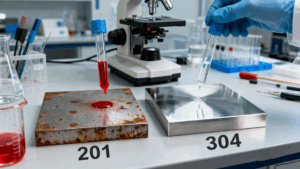One of the most common materials for industrial equipment, kitchenware, sports bottles, and insulated water bottles is stainless steel. However, in an effort to cut costs, many manufacturers combine inferior materials or even use imitation stainless steel in response to the growing demand worldwide. Before making big purchases, private label brands, wholesalers, and resellers should be aware of how to tell if stainless steel is authentic by confirming its grade and understanding how to tell if it meets their quality needs.
Without the need for a lab, this guide explains how to use straightforward testing techniques to determine whether stainless steel is authentic. Knowing how to directly tell if stainless steel falls into distinct grades such as 304 or 201 can aid in ensuring quality.
Common Stainless Steel Grades in Drinkware
| Grade | Type | Features | Application |
|---|---|---|---|
| 304 Stainless Steel | Food-grade (18/8) | High corrosion resistance, safe for hot drinks | Insulated bottles, coffee tumblers |
| 201 Stainless Steel | Lower cost | Medium corrosion resistance | Promotional water bottles |
| 316 Stainless Steel | Medical-grade | Excellent anti-corrosion | Baby bottles, marine use |
How to Determine the Veracity of Stainless Steel
1. Magnet Test (Easy & Fast)
To test, press a magnet up against the steel’s surface in your endeavor to understand if stainless steel is of a particular grade.
Outcome:
The magnetic pull of 304 stainless steel is either weak or absent.
201 stainless steel has a stronger magnetic pull.
Extremely high magnetism in fake steel (iron)
Note: The magnet test is useful for rapid screening but isn’t 100% accurate by itself.
✅ 2. Saltwater Rust Test
How to conduct a test:
Add a tiny pinch of salt to some warm water.
After wiping the steel surface, wait a day.
Outcome:
304 stainless steel doesn’t rust.
Small rust spots on stainless steel 201
Fake steel rusts easily and heavily.
✅ 3. The Spark Test
How to test:
Use sandpaper or a grinder to gently grind the surface.
Outcome:
Genuine stainless steel with few sparks
Big, bright sparks from carbon steel or iron
✅ 4. Test of Weight and Thickness
Compared to inexpensive metal mixtures, real stainless steel feels denser and heavier.
Because inferior steel is used in drinkware, imitation stainless steel bottles may feel light and thin.
✅ 5. Nitric Acid Chemical Test
For expert confirmation:
304 stainless steel does not react with nitric acid.
However, it erodes low-cost iron-based steel.
It works best in labs or factories.
How to Identify Stainless Steel Grade (201 vs 304)
| Test | 201 Stainless Steel | 304 Stainless Steel |
|---|---|---|
| Magnetism | Stronger | Weak or none |
| Rust resistance | Medium | Excellent |
| Price | Lower | Higher |
| Use in drinkware | Budget | Premium food-grade |
How Diller Ensures Stainless Steel Authenticity
As a professional stainless steel drinkware manufacturer in China, Diller uses certified 304 and 316 stainless steel for premium bottles. Every batch of raw material is tested with metal analyzers, and we can provide SGS and FDA reports for verification.
✅ Material report available
✅ Food-grade testing support
✅ OEM & ODM stainless steel drinkware manufacturing

